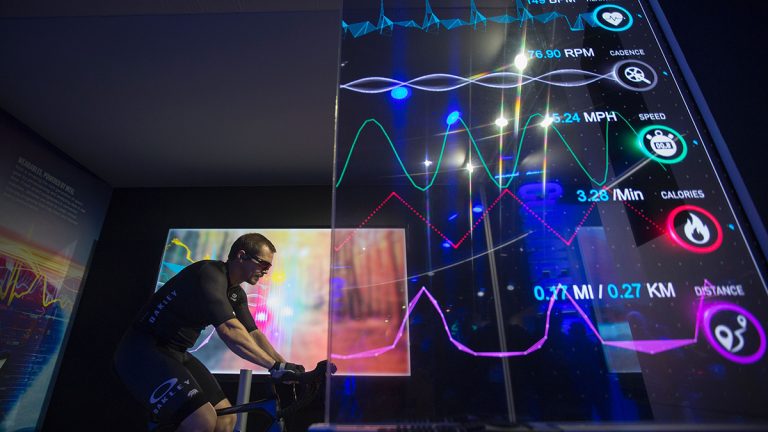Biotechnology could be the new alternative to pain management
Why this matters
No one enjoys being injured. With new technology like a nanotech patch, individuals have a new way to alleviate pain that is keeping them out of the game.
No one enjoys being injured, especially athletes. Whether you’ve pulled a muscle or sprained an ankle, dealing with pain is inconvenient.
For more intense injuries such as ACL tears or for chronic migraines, pills may be necessary to help calm unbearable pain. However, medication can lead to addiction and internal health complications.
With creams and pills often failing to reduce pain, sufferers seek innovations, and new advances in biotechnology are changing the way athletes such as David Prince, a Paralympian sprinter in track and field, cope with their discomfort.
“There are all kinds of lotions and potions and things, and I’ve been in physical therapy for years and years,” Prince said.
After a particularly frustrating injury, Prince discovered help in a pain-relieving patch. The Kailo Nanotech Patch is an innovative biotech patch designed to collaborate with the electrical signals in the body. Kailo is a noninvasive, reusable healing patch that can be worn for an extended period of time, and it starts working immediately.
The patch consists of three layers. The top layer is a non-conductive layer of synthetic polyester, and the second layer is made up of nanoparticles.
According to NerdTechy.com, “when you’re wearing Kailo, you may feel your Kailo begin to warm as your nervous system responds to it. It’s those nano capacitors which are the particles which are tasked with interacting with the electrical system of the body.”
The third layer consists of nanoparticles that are covered in a substrate that holds the particles in place. This gives the patch an enclosed design, making Kailo waterproof.
The overall design of Kailo is similar to a biotech Band-Aid. By interacting with the nervous system pathways in the body’s electrical system, Kailo’s design is efficient and easy to use.
Prince, who specializes in the 200-meter and 400-meter sprints in track and field, says he was at the lowest point in his life when he discovered Kailo.
“I was competing at a meet in Oklahoma City and sprained my hip abductor coming off the turn of a 200-meter,” Prince, an amputee, said. “I was running on a leg that was a little bit lighter than the one that I trained on, and I just came off the turn and my abductor couldn’t handle it. My wife had been researching stuff online, and a Facebook ad for the Kailo patch appeared. She contacted the company and got a couple of patches about two weeks later.”
Recovering from an almost career-ending injury, Prince found the Kailo patch was his saving grace, providing him the strength and comfort to continue training.
“The relief was instantaneous. After that injury in Oklahoma, I was still having a lot of issues,” he said. “I was walking around fine, but it was still very aggravated. I hadn’t worked out or gone on a track just out of fear of re-injuring my leg. When I got the patches and went out there and had them on and did my warm-up, I didn’t feel a thing. I did my workout and didn’t feel anything. It was weird. It was very, very odd.”
Using the Kailo patch as his own supplemental form of physical therapy, Prince went on to make the U.S. team for the Parapan American Games and won a gold medal in the 200-meter event.
Even though the Kailo patch is not an alternative to physical therapy, Prince believes that it is a healthier alternative to pills for alleviating pain and discomfort.
“I’m definitely not saying that the Kailo patch is a way to not have to do physical therapy,” Prince said, “but when you can numb your pain, it helps you focus on the exercises the right way, and it’s definitely a different way of doing things.”
Before the Kailo patch, Prince said he had believed that his body had officially given out.
“After my fall in Oklahoma City, I thought, ‘That’s it. My body has shown me that it’s too old and can’t keep up, and I should just quit and stop.’ But the Kailo patch helps my muscles not be as sore, and it helps with fatigue when I’m running a hard workout,” Prince said.
After using the patch consistently, Prince says it’s difficult to notice the effects; however, anytime he forgets the patch, he feels a noticeable difference in training.
“I definitely recommend it to anyone with a dull, nagging pain,” Prince said. “If you break your leg, it’s not going to help much with pain there, but there are specific pains that it’s going to help you manage.”
With the help of the Kailo patch, Prince has his eyes set on the 2020 Tokyo Paralympic Games.
Samantha Sloman is an senior sports journalism student at Arizona State University





